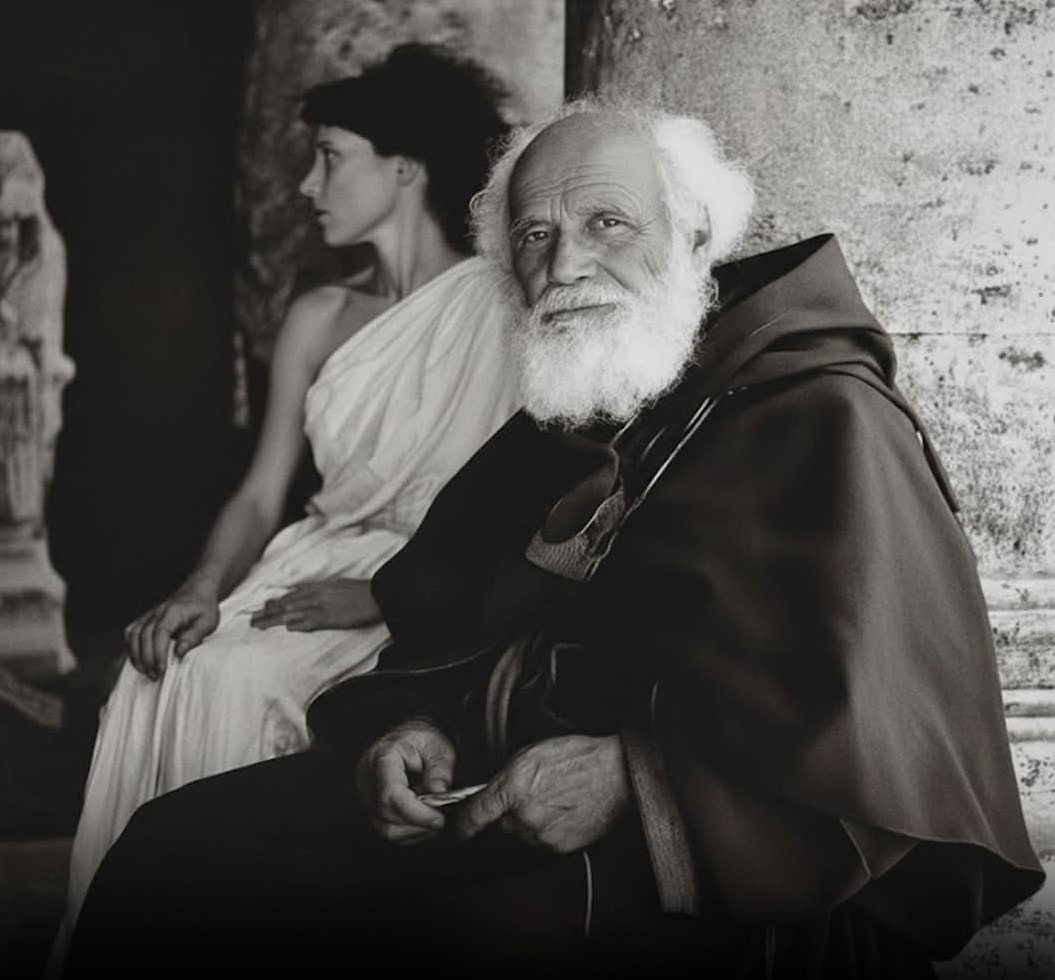Imagine a holy man branded a sinner for haunting the shadows of Alexandria’s brothels—night after night, whispers of scandal ripping through the city’s pious heart. But what if his “vice” was the ultimate act of mercy?
In 625 AD, a weathered monk named Vitalis shuffled into the glittering sin-den of ancient Alexandria, trading desert prayers for backbreaking labor. Every dusk, he’d vanish into those forbidden doors, earning jeers from the faithful who called him a hypocrite. The truth? Buried deeper than the Nile’s secrets, it would shatter souls and flood streets with tears upon his death. A hidden vow, redeemed lives, and a message that still burns: Judge not, lest you miss the divine in disguise.
This forgotten saint’s saga hits like a thunderclap—redemption wrapped in ridicule. Hero or heretic? Uncover the full, heart-wrenching tale that changed a city forever. Tap the link and let it stir your soul:

In the sweltering haze of 625 AD, as the Byzantine Empire clung to its fraying edges amid Persian invasions and theological tempests, the port city of Alexandria stood as a beacon of ancient splendor—and simmering vice. Home to the fabled Library of Alexandria, whose scrolls once housed the world’s knowledge, and a bustling crossroads of Greek philosophers, Coptic Christians, and Arab traders, this Egyptian metropolis pulsed with intellectual fervor and moral ambiguity. Grand basilicas echoed with debates over Christ’s dual nature, while the harbors teemed with spice ships from India and silk caravans from the East. Yet beneath the marble colonnades and torchlit forums lurked a darker underbelly: overcrowded tenements rife with poverty, where desperate souls—often young women trafficked from rural villages or war-torn provinces—were funneled into the shadowy economy of prostitution. It was into this cauldron of contrasts that a 60-year-old hermit from Gaza’s arid monasteries arrived, disguised as a ragged day laborer. His name was Vitalis, and his clandestine crusade would ignite scandal, redemption, and a posthumous reckoning that left the city in collective tears.
Vitalis’s origins were steeped in the ascetic traditions of early Christian monasticism, a movement that had flourished in Egypt since the third century. Born sometime in the late sixth century near Gaza—modern-day Palestine, then a frontier outpost under Byzantine rule—Vitalis entered the Monastery of St. Seridus as a young man. This remote desert enclave, nestled amid sand-swept cliffs and date palms, was a bastion of hesychasm: silent prayer, manual toil, and unyielding renunciation of worldly ties. Founded in the fifth century by St. Seridus the Elder, the monastery drew hermits seeking to emulate the Desert Fathers like St. Anthony the Great, who had fled Roman persecution to wrestle demons in solitude. Vitalis spent decades there, his days a rhythm of weaving baskets from reeds, copying psalms onto papyrus, and prostrating before icons in a cell lit only by flickering oil lamps. By his fifties, he had mastered the art of apatheia—inner impassivity to passions—and was revered as a spiritual elder, or geron, guiding novices through visions and vigils.
But around 625 AD, as the empire reeled from the Sassanid Persian sack of Jerusalem in 614, Vitalis felt a divine unrest. Hagiographic accounts, preserved in the tenth-century Synaxarion of Constantinople and later Orthodox synaxaria, describe a pivotal moment: alone in his cell, Vitalis meditated on the Gospel of John (8:1-11), the story of the adulterous woman spared by Jesus with the words, “Neither do I condemn you; go, and sin no more.” The narrative struck him like a thunderbolt. In an era when prostitution was both a grim economic reality and a theological flashpoint—condemned in patristic writings like St. John Chrysostom’s homilies as a “plague on the soul”—Vitalis resolved to act. At an age when most monks sought deeper seclusion, he abandoned the safety of Gaza for Alexandria, some 300 miles southeast across the Sinai sands. Disrobing his monastic habit for beggar’s rags, he adopted the guise of a wandering laborer, his face weathered by sun and supplication, his only possessions a beggar’s staff and a hidden list: the names and haunts of every known prostitute in the city.
Alexandria in the seventh century was a powder keg of diversity and decay. Founded by Alexander the Great in 331 BC, it had ballooned to over half a million souls by late antiquity, its population a mosaic of Greeks, Egyptians, Jews, and a burgeoning Christian majority under the Coptic Patriarchate. The city’s economy thrived on grain exports to Constantinople, papyrus production for imperial decrees, and a notorious red-light district clustered around the Canopic Way and the Eunostos Harbor. Prostitution, while illegal under Byzantine law (Theodosian Code, Book IX), was tacitly tolerated as a safety valve for sailors and soldiers, with brothels—known as pornēia—operating openly in back alleys. Women in this trade were often victims of circumstance: orphans sold by guardians, war captives from the recent Vandal and Persian conflicts, or impoverished daughters from the Nile Delta’s flood-ravaged farms. Church fathers like Origen, who taught in Alexandria two centuries earlier, had railed against such “dens of iniquity,” yet enforcement was lax; tax records from the period suggest brothels contributed to municipal revenues.
Vitalis’s method was as audacious as it was subversive, a calculated inversion of monastic norms that prioritized hidden virtue over public piety. Each dawn, he joined the throng of day laborers at the city’s agoras—unskilled workers hauling stone for aqueduct repairs or unloading amphorae of olive oil from Levantine galleys. His earnings, meager coppers scraped from callused palms, amounted to perhaps a single silver miliarensis per day—enough for basic sustenance or, crucially, to “purchase” an hour in a brothel. By evening, under the cover of twilight markets where vendors hawked figs and frankincense, Vitalis would approach the pornēia: dimly lit warrens of mud-brick hovels adorned with faded frescoes of Venus and Eros. To avoid suspicion, he announced his destination loudly—”To the house of Maria the Harlot!”—drawing stares from passersby and fueling rumors of his debauchery.
Inside, the truth unfolded in whispers. Vitalis would hand over his wages not for carnal indulgence, but as a ransom for the woman’s time. “Tonight, you are bought for prayer, not sin,” he would say, according to hagiographer Simeon Metaphrastes’ ninth-century account. Seated on threadbare pallets amid the scent of cheap myrrh and stale wine, he recited Psalms—Psalm 51’s plea for a “clean heart” or Psalm 137’s lament over exile—while the woman rested, free from the night’s predations. He spoke of God’s boundless mercy, drawing from the parable of the Prodigal Son (Luke 15) to affirm her inherent dignity as an icon of the divine. Many, touched by his earnest gaze and unjudging presence, wept for the first time in years. Vitalis arranged escapes: dowries from sympathetic merchants, marriages to kind-hearted artisans, or entry into women’s monasteries like that of St. Menas near the Mareotis Lake. One legend recounts a girl named Theodora, once a temple dancer enslaved after the Persian wars, who under Vitalis’s guidance wed a Coptic scribe and bore seven children, her descendants later venerating him as a family patron.
To safeguard his mission, Vitalis bound each convert to secrecy with a solemn oath: “Reveal not this grace, lest the doors close forever.” This vow, invoked under threat of divine displeasure, ensured his access remained unimpeded—pimps and madams, seeing only a harmless eccentric, waved him through. Yet the camouflage exacted a toll. Word of the “lecherous monk” spread like Nile silt after floods. Passersby hissed “hypocrite!” as he trudged to the brothels; children pelted him with stones; even fellow Christians, scandalized by this breach of clerical decorum, petitioned Patriarch John V (r. 606-616, though timelines vary) to excommunicate him. John, known as “the Merciful” for ransoming Persian captives, intervened quietly, quelling the uproar with appeals to Matthew 7:1—”Judge not, that ye be not judged.” Vitalis endured in silence, his only retort to accusers: “Have I not a body like other men? Are monks exempt from temptation’s pull?” This deflection, laced with feigned worldliness, only deepened the city’s disdain.
For five grueling years—his mission’s approximate span—Vitalis cycled through Alexandria’s underclass, redeeming an estimated 200 women, per Orthodox tradition. His impact rippled outward: brothels emptied, families reformed, and whispers of “miraculous conversions” reached the patriarchal court. Yet societal fissures widened. In an age of Christological schisms—the Monophysites clashing with Chalcedonians over Christ’s nature—Vitalis’s unorthodox zeal mirrored broader tensions. Pro-slavery apologists in the church hierarchy viewed his interventions as meddling with “necessary evils,” while radical ascetics decried any urban engagement as compromise. Economically, his actions disrupted a shadow trade that funneled silver to corrupt officials; one apocryphal tale claims a brothel owner, enraged by lost revenue, set dogs on him. Psychologically, Vitalis wrestled vainglory—the sin of pride in good works—by embracing public shame, embodying St. Paul’s “fool for Christ’s sake” (1 Corinthians 4:10).
The climax came one humid autumn eve in 625, amid rumors of an impending Arab raid from the east. Vitalis, weakened by age and privation, entered the home of a woman named Pelagia, a former actress fallen on hard times. As he emerged, reciting the Jesus Prayer—”Lord Jesus Christ, have mercy on me, a sinner”—a young Christian man, perhaps a deacon’s son slumming in vice, mistook his intent. Overcome by righteous fury, the youth struck Vitalis on the head with a sailor’s belaying pin, bellowing, “Disgrace to the faith!” Blood streaming, Vitalis staggered to his humble cell—a lean-to shack near the necropolis—where he collapsed on his knees before an icon of the Theotokos. In his gnarled hand, he clutched a wax tablet inscribed with 1 Corinthians 4:5: “Therefore judge nothing before the appointed time, until the Lord comes, who will both bring to light the hidden things of darkness and reveal the counsels of the hearts.”
Dawn broke to a city astir. The youth, haunted by remorse, raced to the cell, confessing his sin to a gathering crowd. Breaking down the door, they found Vitalis cold, his face serene in death. Word spread like wildfire through the forums and basilicas. Then, the floodgates opened: the redeemed women, released from their oaths by his passing, emerged in procession—clad in modest veils, some with babes in arms, others as nuns. “He was our savior, not our seducer!” they cried, recounting tales of midnight psalms and tearful baptisms. Over a hundred, by legend, bore candles and lanterns, parading his body to the Church of St. Mark amid wails that echoed to the Pharos Lighthouse. Alexandria wept—not just for the loss, but for the mirror held to its soul. Patriarch John, leading the funeral, proclaimed, “We judged hastily, and heaven has judged us.” The youth, struck by divine irony, suffered a seizure mirroring Vitalis’s wound, only to recover and enter monastic life.
Vitalis’s legacy, canonized swiftly in Eastern and Western traditions, transcends hagiography. Venerated on January 11 (Orthodox) and April 22 (some calendars), he is patron of prostitutes, day laborers, and reformed sinners—his intercession invoked in modern anti-trafficking prayers. Medieval icons depict him with a beggar’s satchel and a scroll of Psalms, flanked by veiled women. In the Enlightenment era, his vita inspired Enlightenment thinkers like Voltaire, who cited it in Candide as a parable against hypocrisy. Nineteenth-century abolitionists, from Harriet Beecher Stowe to Frederick Douglass, drew parallels to his ransoming of the enslaved, seeing echoes in the Underground Railroad.
Today, as global sex trafficking ensnares 25 million (per UN estimates), Vitalis’s story resonates amid #MeToo reckonings and faith-based rescues. Organizations like the International Christian Anti-Human Trafficking Alliance reference his model: discreet intervention over public shaming. In Gaza and Alexandria—now strife-torn—pilgrims visit sites tied to his memory, like the ruins of Seridus’s monastery. Archaeologically, seventh-century papyri from the Oxyrhynchus cache corroborate Alexandria’s social strata, with contracts for “pledged women” mirroring his era’s vulnerabilities.
Yet Vitalis challenges beyond charity: his embrace of scandal prefigures Jesus’s table-fellowship with tax collectors (Mark 2:15-17), demanding believers risk reputation for the marginalized. In an age of cancel culture and performative piety, his tablet’s warning endures: hasty judgments blind us to hidden graces. As one Coptic hymn intones, “In the brothel’s shadow, light was born; in scorn’s embrace, a saint was worn.” Vitalis of Gaza, the beggar who stormed sin’s citadel, reminds us that true holiness often hides in plain sight—humble, misunderstood, and eternally merciful.





